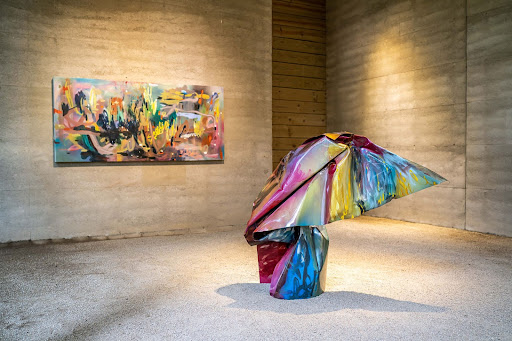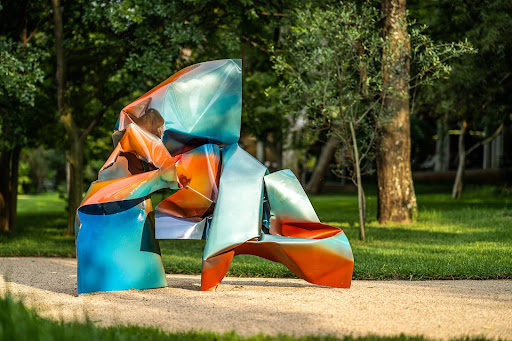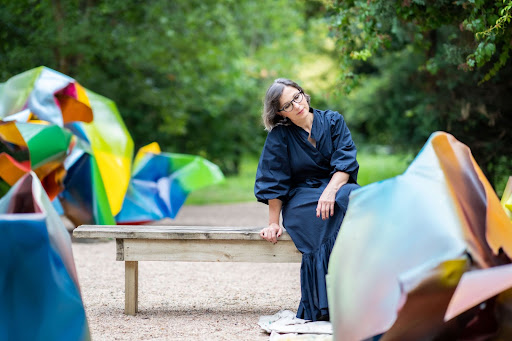Mother, 2022, automotive paint on aluminium. (Photos: Alexi Portokallis)
An imaginative leap is required to connect the aesthetic experience of contemporary artworks with what is simultaneously happening in the world. This is a rewording (with liberties taken) of art critic John Berger’s writing, in 1955, in response to the testing of the hydrogen bomb.
Fifty years later, Berger wrote Here Is Where We Meet, a book that could be fiction, autobiography, reflection or essay and from which Hedwig Barry borrows the title of her exhibition at Nirox Sculpture Park in 2022. Barry’s work responds to the deep uncertainty of our current times in a way that resonates with the lyrical and reflective transposing of place, time and memory that shapes Berger’s writing in Here Is Where We Meet. Rather than demanding an imaginative leap, her paintings and sculptures encourage the substitution of the desire to know with feeling and intuition.
Hedwig Barry has the enthusiasm of someone who has worked hard and waited patiently for the space and support that enables art making. When she talks about her work, it is without cynical asides. She is so very glad to be here, at the Nirox Sculpture Park, where her first solo exhibition is the culmination of a seven-week residency and many years of teaching, learning and hustling.
 Installation view showing the works Johannesburg and Angel of History (L-R)
Installation view showing the works Johannesburg and Angel of History (L-R)
Barry graduated from Wits School of the Arts with an MA Fine Arts in 2020. The same year BMW, in collaboration with Wits University, commissioned her to create Crumple and Love Letter for Lost Travellers, two large-scale interventions at the BMW Campus in Midrand. Another of her crumples is currently on exhibition at Everard Read, Johannesburg. Behind her, she has careers in directing for film and television, creative direction in art and design, and extensive experience teaching at secondary and tertiary institutions. She remains committed to the latter, both in her practice and in her research, in which teaching and learning is a central element.
In Barry’s sculptures, extreme, indiscriminately applied force meets the careful application of lurid colour and soft marks. Her crumples sit lightly on their sharp edges and make the green of Nirox’s lawns look sprayed-on. They are the vivid aftermath of a material process that begins when an orange peel grab or grapple, also known as a hydraulic press, descends and transfigures flat aluminium sheets. This giant brute of a hand is a crude artistic tool (to put it mildly), whose unwieldy facility is central to Barry’s practice. Though some manipulation is possible, she has limited control over the forms that are wrought from the process. The surface of these forms is the base for a material exploration involving colour and marking, and a play of light and shadow that will continue to transform the work long after the paint has dried.
Relinquishing control in such an extremely deliberate way is a provocative move. For all the complications and contradictions of the term in a contemporary context, Barry considers herself a feminist. What this represents for her is a resistance to dominant systems of oppression and control engendered by social hierarchy and, in particular, the subtle ways in which these systems are used to demean people. She runs against the prioritisation of rational modes of thought and decision-making and is guided by emotion, empathy and intuition in her work and life. By creating the conditions for chance to be so forcefully enacted, and for the memory of that force to be captured in the resulting form, the artist proposes a dramatic alternative to logic. The work is conceived from a crash.
 Sharkboy, 2022, automotive paint on aluminium
Sharkboy, 2022, automotive paint on aluminium
Far more than an act of resistance, Barry’s crumples are a gesture towards the human capacity for recovery and growth in spite of sometimes overwhelming odds. “Crumple zones” are designed to protect the life of a person in a vehicle by absorbing the impact in case of an accident. Barry extends this defensive measure in her sculptures as a reflection on fragility and the ways in which we transform ourselves in the face of trauma and difficulty in our lives. The crumples give shape to the intangible experience of grief and renewal. The space of unknowing that distinguishes their fabrication is generative for the artist, and an essential component of her working process in any medium, including in her painted work.
In 2019, Barry’s figurative painting practice began to dissolve into a way of working compelled by mark making. Without a representational anchor, the relationship between form and ground is loosened. Colour, texture and movement describe ephemeral states in Barry’s affective compositions.
In the painting Tswalu heat radiates from the surface of the canvas through a base of sprayed and layered red, pink, orange, green and grey. Flat orange, pink and red strokes simmer and give way to swirling yellow that rises into dark and murky cloud forms. Tswalu, a reserve in the Kalahari, is very hot and, according to the artist, getting hotter. The painting Johannesburg is familiar with its frenzy of brown, black, green and pink – storms and traffic perhaps, with intermittent charm in bright blue skies.
 Artist Hedwig Barry at Nirox Sculpture Park
Artist Hedwig Barry at Nirox Sculpture Park
Barry’s paintings are unsettling. They don’t let you settle. Their compositions decompose. You can lose yourself in a soft, receding oceanic consistency only to be thrown out by a vivid projectile. These marks and textures are extended in some of her sculptures. Once again, the effect is unsettling. Shadows that move in the folds of the work and shift throughout the day are redirected and confused by ecstatic automotive paint. Soft, stippling and twirling brush strokes that are added to the surface of the crumples bring another dimension to the very active engagement that the works demand.
This affective meeting of the viewer and the work is one of several that this exhibition tenders. The “here” of Here Is Where We Meet is where we reconcile with the forces that propel and interrupt each of our lives, where we are confronted by what we’ve lost in the traces left behind, where we meet and resist our own mortality and where we find one another in this resistance.
There are moments in this exhibition where the clash of high gloss and matt automotive paint, euphoric colour, restless compositions and warped forms feel like fragments of an apocalyptic rave. “Not knowing”, “grounding” and “groundlessness” are the terms used to describe the metaphorical space in which Barry works. Without knowledge or ground, it can be hard to know how to feel.
Here Is Where We Meet is curated by Anthea Buys of Forms Gallery at the Nirox Sculpture Park. Forms Gallery represents a small cohort of artists (including Hedwig Barry), and functions without a permanent space, through collaborations with like-minded people, spaces and organisations and on the internet. Here Is Where We Meet runs until 13 March 2022. This text has been adapted from its original format, which accompanied the exhibition